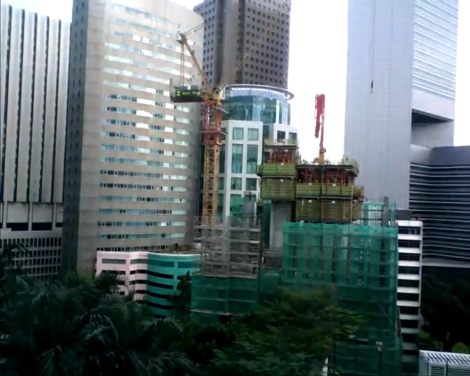
When [Bunny] moved into his apartment in Singapore he was surprised to find that a huge building project was just getting started on the other side of the block. Being the curious sort, he was always interested in what was going on, but just looking in on the project occasionally wasn’t enough. Instead, he set up a camera and made a time-lapse video.
This isn’t hard, you can find a slew of intervalometer projects which we’ve covered over the years. But being that [Bunnie] is one of the designers of the Chumby One, and frequently performs hacks on the hardware, it’s no surprise that he chose to use that hardware for the project.
Luckily, he’s sharing the steps he used to get Chumby capturing images. He mentions the hardest part is finding a compatible USB camera. If you have one that works with a 2008 Linux kernel you should be fine. The rest is done with shell scripts. Mplayer captures the images when the script is called from a cron job. Once all the frames are captured, he used mencoder to stitch the JPEGs into a movie. See the result after the break.
[youtube=http://www.youtube.com/watch?v=bJFdCW1ftiI&w=470]














Very nice :) I did the same thing before, except I had the image FTP’d offsite.
The problem I had is that although I could find lots of compatible cameras, none of them gave anywhere near the same quality in Linux as they did in Windows. Like a huge huge difference.
I tried for a long time to find a good quality webcam that worked well in linux. I now use a Logitech C910 HD Pro and the quality is pretty fantastic. I use it on a fedora 14 machine, cheese, gmail video call and skype all work fine with the camera. You can choose the resolution too. Can’t recommend it enough.
Although very cool I think that it would make a better video if 1 or two images per day were used – it just seems too slow at the moment and you end up clicking through the video to see the progress.
2 or 3 times faster would have been great. Still looks really good, nice job, but it got boring after a few minutes. At that point I still wanted to see the rest, but faster.
I would have liked to have seen autoexposure utilized from the camera. The changes from overexposed to underexposed was very distracting.
I <3 Bunnie!
He should make a video using only 1 image each day, shot at the same time during the day, for example at noon. That would both make the video fast enough to be interesting the whole time, and get rid of the irritating exposure flashes.
Agreed.
The original theory was that it’s better to have too much data than too little. By taking an image four times per hour, you can throw away most of them to get a once-per-day image, or do something really clever and throw out frames that are uninteresting.
Exactly but it must be followed through. Eliminating the night time exposures would be a good start too.
I think about 3 images per day would be perfect, but with a manual exposure pre-set so you don’t get quite as much change.
Night time images are just not interesting because you can’t see progress. So I would do ~8am, 12noon, 5pm.
I agree with above posters, that it gets boring after a few minutes, but I did watch about 5 minutes of it.
I really like bunnie’s low power capture using a chumby. If he’s saving images to a NAS, he could automate the video building across different timescales similar to what I did. http://www.ragingcomputer.com/archives/85
I’m going to blame bunnie for any more chumbys I buy.
Very nice, I love timelapse movies. The other problem with this movie is that the camera is facing directly the sun. But I guess you cannot always choose your location, you work with what you got!